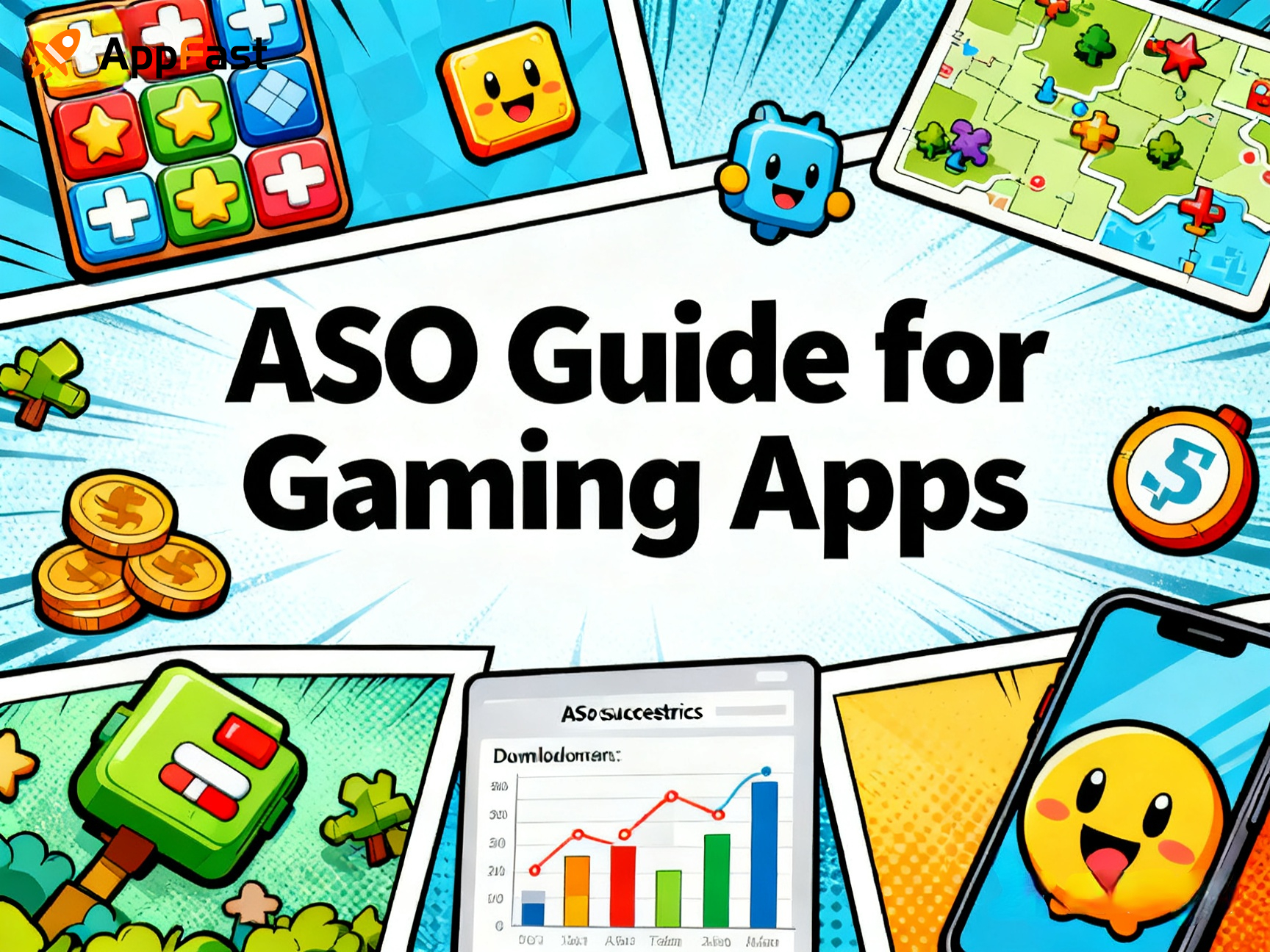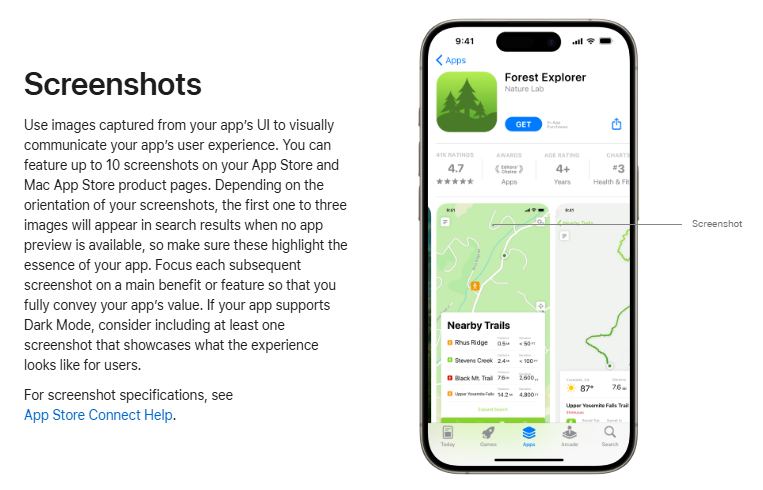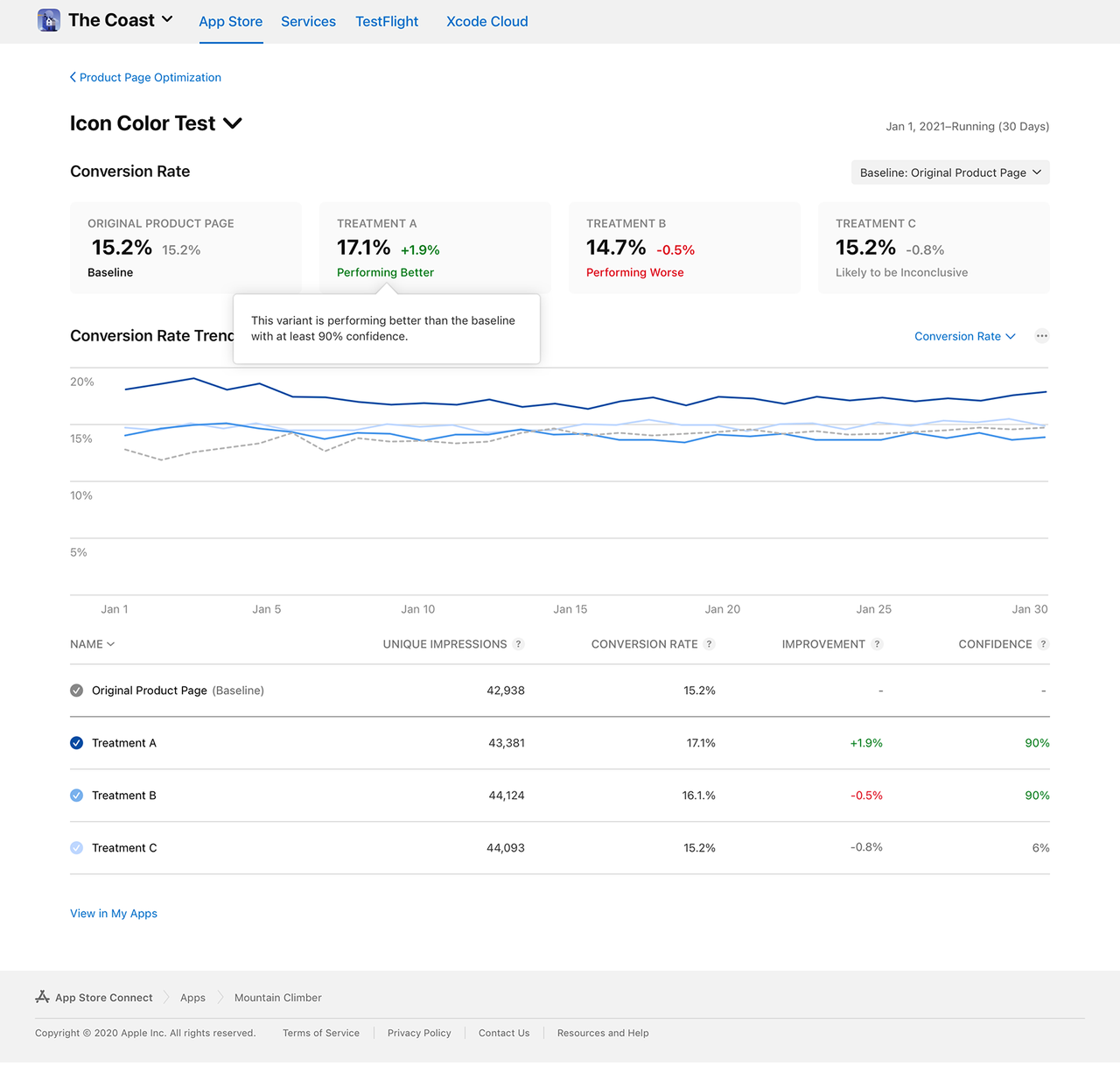
Loading...
Free consultation with ASO specialists
Doing ASO for the first time or have no idea how to carry out targeted optimization of your app?
We offer one-on-one customized services provided by app marketing specialists
ASO Special Guide for Gaming Apps: Exclusive Secrets to Boost Exposure, Clicks, and Downloads
2025-10-10

Meta description:Master ASO optimization techniques for gaming apps to enhance visibility and downloads in the App Store. This guide shares exclusive tips on keyword research, metadata optimization, visual asset design, and improving user Ratings, helping gaming apps attract more organic traffic.
Why gaming apps need ASO optimization
The mobile gaming market is extremely competitive, with a large number of new games being launched on app stores every day. According to statistics, global in-app purchase (IAP) revenue for mobile games rebounded to between 81 and 82 billion US dollars in 2024, representing a year-on-year increase of approximately 4%. However, at the same time, total app downloads declined by 6-7%. This means that player acquisition costs are rising, and game developers must place greater emphasis on app store optimization (ASO) to stand out.
App Store Optimization (ASO) refers to a set of strategies aimed at improving an app's organic search ranking and visibility in app stores by optimizing its presentation and information, thereby increasing downloads. For game apps, ASO is especially important:
-
Increase exposure
The app store is one of the primary channels through which players discover new games. Optimizing a game's metadata can help it rank higher in search results for relevant keywords, reaching more potential users. For example, if a game is optimized for keywords related to popular genres or gameplay styles, it will have a better chance of appearing in the results when players search for similar games or gameplay.
-
Improve click-through rate
The title, icon, Ratings, and other elements of apps in search results directly influence whether users click to view details. Excellent ASO optimizes these elements to make them more attractive and relevant, thereby improving click-through rates.
-
Promote downloads
When the game is visible in search results and users click to enter the detail page, a carefully optimized app description, screenshots, Ratings, and Reviews will further persuade users to download the game. An effective ASO strategy can significantly boost the game's download volume.
-
Enhance user retention and word-of-mouth.
ASO not only affects pre-download conversion but is also related to the post-download user experience. By optimizing the app title, subtitle, and description to clearly communicate the game's features and gameplay, we can reduce uninstallations caused by information mismatches and improve user retention. Meanwhile, encouraging satisfied players to leave Reviews and promptly responding to user feedback helps build a positive reputation, creating a positive cycle of downloads and Ratings.
In short, with the slowdown in the mobile gaming market and soaring user acquisition costs, ASO has become an essential skill for game developers to attract users. Next, we will delve into the key steps and practical tips for ASO of game apps.
The search ranking of keywords directly determines whether your game can be discovered by target players. If you wish to systematically improve the search rankings of your core keywords, feel free to learn about AppFast's 【Keyword Ranking Improvement Service】. We can provide you with a free diagnosis of your current keyword ranking status and develop results-oriented optimization strategies to help your game achieve leading exposure.
Key Steps for ASO of Game Apps
To effectively perform ASO for game apps, you need to start from multiple aspects such as keyword selection, metadata optimization, visual material design, and user Reviews maintenance, forming a systematic optimization process. Here are the five key steps to enhance game exposure, clicks, and downloads:
-
Keyword Research and Selection
Keywords are the foundation of ASO. By studying the commonly used search terms by players in app stores, selecting keywords that are relevant to the game and have a certain search volume, and strategically placing them within the app's metadata, you can significantly increase the likelihood of your game being found in searches.
-
Use tools to mine keywords
You can use ASO tools (such as UPUP) to obtain popular search terms for the game category, as well as keywords currently used by competing apps, to identify keywords that are gaining traction among players.
-
Balancing popularity and competitiveness
Popular keywords have high search volumes but also intense competition, making it difficult for new games to rank highly in the short term. Therefore, when selecting keywords, you need to make trade-offs, choosing those that are moderately popular without being overly widespread. It is recommended to adopt a combination strategy of "core keywords + long-tail keywords": core keywords (such as game genres or gameplay names) provide basic exposure, while long-tail keywords (such as combinations of specific gameplay or themes) precisely target niche audiences.
-
Cover different user intents
Consider the possible search intentions of players; for example, users searching for "puzzle games" might be looking for brain-teasing games, while those searching for "role-playing mobile games" are more explicitly seeking RPG titles. Game developers should ensure that keywords cover major genres, gameplay styles, and features, while avoiding the indiscriminate stacking of irrelevant keywords.
-
Localized keywords
If the target market includes overseas regions such as the United States, pay special attention to English keywords commonly used by local players. Even if the game itself supports Chinese, you still need to optimize with English keywords on the English App Store. For example, in the U.S. market, you can include popular gaming genre terms orAdd to backend keywordsBrand IP names (such as "Pokemon," "Mario," etc.) to attract players with relevant interests.

It's important to note that keyword selection is not a one-time task, but rather something that should be continuously monitored and adjusted. Regularly checking changes in keyword rankings and search volume trends, promptly replacing underperforming keywords with new popular ones, will ensure that ASO effectiveness stays up-to-date.
-
Metadata optimization
App store metadata refers to textual information such as the app title, subtitle (short description), description, and keyword fields (iOS). These elements not only affect the app's ranking in searches but also directly convey the game's core information to users. When optimizing metadata, you should include high-value keywords and highlight the game's selling points as much as possible, while adhering to platform guidelines.
-
App title
Game titles usually include the game name and its core positioning. Given the limited length of iOS titles, it's important to keep them concise and impactful. It's recommended to place the most important keywords or game genre at the beginning of the title, while ensuring it flows smoothly and is easy to remember. For example, a match-3 mobile game could be named "Candy Crush – Casual Puzzle Game," where "Casual Puzzle Game" clearly indicates the genre and helps attract users searching for related content.
-
Subtitle (short description)
The subtitle for iOS can be filled with approximately 30-50 characters, while Android has a dedicated "short description" field (80 characters). In the subtitle, you can highlight the game's unique features or genre, such as "3D multiplayer online shooting mobile game" or "brain-teasing puzzle escape game," further enhancing alignment with users' search intentions.
-
App description
The long description is where you provide users with a detailed introduction to the game. In ASO, the description needs to balance SEO and readability: on one hand, you can reasonably incorporate some relevant keywords (but avoid keyword stuffing) to enhance the relevance between the description content and search queries; on the other hand, use vivid language to tell the game's story, highlight its gameplay features, and introduce new updates, thereby sparking user interest. It is recommended to use clear paragraphs and subheadings (if supported by the platform) to allow users to quickly scan through the content. At the end of the description, you can include a call-to-action, such as "Download now and embark on an adventure!" to encourage users to download.
-
Keyword field
In the iOS App Store, developers can fill in a keyword field with up to 100 characters. This field is not visible to users but affects search matching. Important keywords not reflected in the title and subtitle should be placed here to cover more potential searches. It's important to avoid repetition and words unrelated to the game.
After metadata optimization is completed, you should repeatedly check for typos and ensure the accuracy of the information, and also make sure that metadata versions in different languages have all been localized and optimized. The optimized metadata should not only meet ASO requirements but also clearly convey the game's unique selling points (USPs), allowing users to instantly recognize the value of this game.
-
Visual Material Optimization
In app stores, visual assets—including icons, screenshots, preview videos, and more—play a decisive role in users' first impressions and click-through conversions. Therefore, a game's visual assets must quickly capture users' attention and effectively communicate the game's core gameplay and appeal.
-
App icon
The icon is the game's "business card," and users will see it in search results, leaderboards, and on the device's home screen. A good game icon should be simple and eye-catching, with a clear theme that reflects the game's genre or distinctive elements. For games, including the game's name or IP characters in the icon can enhance recognition and build trust. Additionally, the icon design should comply with platform specifications (such as size and rounded corners) and take into account how it will appear at different resolutions.
-
Screenshots and preview videos
App stores allow uploading multiple screenshots and a preview video (usually 30 seconds to 1 minute). These materials should showcase the game from various angles; the first few screenshots/video clips are especially important and should immediately present the game's core gameplay and exciting moments to capture users' attention. For example, action games can feature intense battle scenes, while puzzle games can highlight brain-teasing level scenarios. Each screenshot can be accompanied by a brief caption highlighting the unique features or new content depicted in that image. At the same time, ensure that the screenshots maintain a consistent style, clear image quality, and avoid spoilers or overly complex information.

-
Localized visual content
If the game targets a multilingual market, visual assets also need to be localized. For example, text annotations in screenshots should be translated into the corresponding languages, and local-language voiceovers or subtitles can be considered for videos. Additionally, players in different regions may have varying aesthetic preferences, so the focus of screenshots and videos can be adjusted according to the target market. For instance, European and American players may prefer visuals showcasing the game's world-building and characters, while Asian players may pay more attention to the game's social features or stunning graphics.
-
Optimize Creatives with A/B Testing
Optimizing visual assets often lacks absolute standards and requires data to validate the results. Both Apple's and Google's app stores offer A/B testing features, allowing developers to show different versions of screenshots or videos to different users to compare conversion rates. Through multiple tests, you can identify which style of screenshots, which display order, or which video clips are most effective in boosting download conversion rates, enabling continuous iteration and optimization.
In short, the goal of visual asset optimization is to clearly convey the fun and uniqueness of the game's gameplay within the few seconds a user spends looking at it, alleviating their concerns and sparking their desire to download. This often requires a combination of design and marketing thinking, as well as continuous testing and improvement.
-
User Reviews and Ratings Optimization
User Reviews and Ratings are important signals for app store ranking algorithms and key factors influencing new users' download decisions. Even if a game ranks high in search results and has attractive screenshots, users are likely to abandon the download if it has low Ratings or negative Reviews. Therefore, maintaining a good user reputation is an essential part of ASO.
-
Actively seek positive Ratings
When the game goes live or a major update is released, developers can timely guide satisfied players within the game to visit the app store and leave positive Reviews. For example, when players complete certain levels or reach a specific rank, a friendly prompt can pop up inviting them to "If you enjoy this game, please give us a five-star Ratings on the App Store." It's important to pay attention to the timing and frequency of such prompts to avoid disturbing users or causing resentment.
-
Promptly respond to user feedback
For the Reviews left by users in the app store, whether positive or negative, they should all be taken seriously. Especially negative Reviews—respond promptly and politely, thank users for their feedback, and outline the measures being taken to improve. Many users in app stores will check developers' responses, which demonstrates the team's重视 of players and helps restore confidence among other potential users. Additionally, engaging with users through responses can also provide valuable insights for product improvement.
-
Continuously improve product experience
In the long run, maintaining high Ratings fundamentally depends on the quality and service of the game itself. Developers should closely monitor issues mentioned by users in Reviews (such as bugs, difficulty, monetization points, etc.) and address them in subsequent updates. Continuously introducing new content, fixing problems, and optimizing performance will keep existing users satisfied and more likely to leave positive Ratings. This virtuous cycle will enhance the game's Ratings and ranking in app stores.
-
Handling low Ratings
If developers encounter malicious negative Reviews or low Ratings caused by misunderstandings, they can reply to clarify the facts or guide users to resolve issues through customer service channels. For genuine problems, they should sincerely apologize and fix them as soon as possible.
It's worth mentioning that the app store's Ratings mechanism is more sensitive to recent Reviews and active users. Therefore, maintaining the game's activity level (such as holding regular events and releasing updates) not only helps retain existing players but also encourages more fresh Reviews, thereby sustaining or improving the overall Ratings.
-
A/B Testing and Continuous Optimization
ASO is not a one-time task, but rather an ongoing optimization process. The app store environment and user preferences are constantly changing; strategies that worked yesterday may become less effective today. Therefore, game developers need to develop data-driven habits byA/B Testingand data analysis to continuously improve ASO strategies.
-
Test different metadata versions
You can conduct small-scale tests by making minor changes to the app's title, subtitle, description, etc., and observe their impact on search rankings and conversion rates. For example, try adding or removing a specific keyword from the title to see if there are any changes in the number of downloads.
-
A/B testing of creative assets
As mentioned earlier, app stores offer A/B testing features for screenshots and videos. Developers can design two sets of screenshots or videos with different styles, distribute them to users in certain proportions, and then compare which set leads to a higher conversion rate. Through multiple rounds of testing and iteration, visual materials can be gradually optimized to find the presentation style that best suits the target audience.

-
Monitor key metrics
During the optimization process, closely monitor key ASO-related metrics, including keyword rankings, search impressions, click-through rates, conversion rates, user Ratings, and the number of Reviews. If certain metrics are not ideal, analyze the reasons and adjust your strategy accordingly.
-
Pay attention to changes in platform algorithms and policies
Apple and Google periodically adjust their app store search algorithms or introduce new policies. For example, Apple launched the Custom Product Pages feature this year, allowing developers to showcase different screenshots and descriptions to various audiences. Developers should stay informed about these changes and adjust their ASO strategies accordingly to align with platform trends.
-
In combination with other promotional methods
ASO generates organic traffic, while game promotion often requires a combination of various methods. ASO can be integrated with app store ads, social media marketing, and KOL promotions. For example, while using Apple Search Ads to gain short-term traffic, you can optimize ASO to improve long-term organic rankings. Additionally, leveraging social media to generate buzz for new game versions can encourage players to search and download in the app store, thereby increasing the popularity of relevant keywords.
In short, continuous optimization requires developers to maintain keen data analysis skills and the ability to iterate rapidly. Only through constant testing, learning, and adjustment can games maintain a competitive edge in app stores.
ASO strategies for different game genres
Different types of games have varying target users and user search habits. Therefore, in ASO practice, it is necessary to tailor strategies to the specific game type. Below, we will discuss the key ASO considerations for casual games, hyper-casual games, and mid-core/heavyweight games separately.
ASO Strategies for Casual Games
Casual Games refer to game genres with simple gameplay, easy to pick up, and short single-session durations, such as match-three, puzzle, and simulation games. They have a broad user base, mostly consisting of casual players, who often discover games through app store searches or Rankings. Search terms tend to be quite general (e.g., "puzzle games," "match-three games"). ASO strategies for these types of games should focus on the following aspects:
-
The keywords highlight the attributes of "relaxation" and "leisure."
Users generally prefer low-pressure, easy-to-learn gaming experiences. Keywords should include emotional terms such as "casual," "relaxed," "stress-relieving," and "brain-teasing," combined with specific gameplay terms like "match-three," "puzzle," and "connect the dots" to cover a wide range of search intentions.
-
Emphasizing ease of play and social elements
In the title, description, and screenshots, it is necessary to intuitively convey the game's features of being simple, fun, and suitable for short bursts of playtime, such as emphasizing "simple controls, enjoy anytime." If the game includes multiplayer battles or social sharing features, these should be prominently displayed in the visual materials to enhance users' willingness to interact.
-
Adopt an approachable visual style
Icons and screenshots should feature bright, cartoonish designs paired with cute characters or props to convey a light and cheerful atmosphere. Screenshots should highlight the game's key features and fun scenes, accompanied by short copy such as "fun" and "addictive," to lower the barrier for users to give it a try.
-
Drive the accumulation of public word-of-mouth.
Casual games rely heavily on user recommendations. We should actively encourage players to leave in-game Reviews, which will increase Ratings and the number of Reviews. Apps with high Ratings are more likely to be featured on popular recommendation lists, thus gaining more organic exposure.
ASO Strategies for Hyper-Casual Games
Hyper-casual games are a more lightweight branch of casual games, featuring extremely simple gameplay and very short session lengths, targeting a broad user base in fragmented usage scenarios. Market competition is fierce, with new titles emerging frequently, requiring ASO to attract users to download within a very short time frame. Strategies should focus on the following points.
-
The keywords point directly to the core gameplay
The game mechanics are simple, and keywords should directly reflect the gameplay type, such as "line-drawing puzzle" for line-drawing games and "io battle" for IO games. Keywords should be generalized to cover the entire category rather than specific versions, accommodating their rapid iteration characteristics.
-
The title is concise and distinctive.
The main title should be short and memorable, while the subtitle can provide additional gameplay descriptions, such as "Minimalist Line Drawing Puzzle" or "Addictive Avoidance Mini-Game," enabling users to quickly understand the game content in search results and increasing their willingness to click.
-
Visual materials highlight "addictiveness" and low learning curve
The first image or the beginning of the video should quickly showcase fun or humorous moments from the game to spark user interest. At the same time, clearly demonstrate simple controls (such as tapping or swiping), accompanied by brief prompts like "Tap to avoid obstacles," to reinforce the perception that it's easy to pick up right away.
-
Combining virus transmission with advertising traffic generation
Most users come from social media or advertisements, so it's important to ensure that the core creative keywords in ads can be found in app stores. You can include genuine player feedback or popular memes (such as "can't stop playing") in the description to enhance virality and trust.
-
High-frequency testing and rapid iteration
The market is changing rapidly, and ASO needs to have the ability to respond quickly. Continuously monitor keyword rankings and conversion data, and promptly replace underperforming creatives. Implement an agile cycle of "test-optimization-launch" by conducting A/B tests on icons, screenshots, and more.
The platform's review and ranking of hyper-casual games take into account metrics such as user retention. Therefore, in addition to ASO optimization, it's also important to focus on the game's own retention performance; positive user data will feed back into app store rankings, creating a positive cycle.
ASO Strategies for Mid-to-Heavyweight Games
Medium- and heavy-duty games typically refer to genres with complex gameplay, deep content, and longer single-session engagement, such as MMORPGs, strategy games, and competitive shooters. Their target users are mostly experienced gamers who have access to a wide range of information sources (such as gaming media and community forums), but app stores remain the crucial entry point for final downloads. ASO strategies must be specifically optimized to cater to the characteristics of this demographic:
-
Keywords focus on professional terms and IP association
Players often use specialized terms like "MMORPG," "open world," "SLG," or well-known IP names in their searches. Keywords should include these high-intent terms, and if the game is adapted from an IP, it must be clearly highlighted in the title or description to precisely attract the core audience.
-
Highlighting the depth and quality of the game
By highlighting the game's storyline, class system, visual presentation, competitive gameplay, and other core strengths through descriptions and visual materials, you can enhance persuasiveness by citing data such as "Global downloads exceed ××" or "Awarded ×× accolades." Screenshots and videos should showcase high-quality visuals and large-scale battle scenes, conveying the richness of the game's content and its production standards.
-
Guide high-quality core users to provide Reviews
The user base is relatively stable and highly loyal, so efforts should focus on encouraging experienced players to write in-depth Reviews that highlight the game's key features. In-game incentives or community interactions can be used to promote high-quality Reviews; a few long Reviews with valuable insights are more effective in driving conversions than numerous superficial positive Ratings.
-
Continuously update store content to align with long-term operations
Games typically release new versions and events frequently, so ASO needs to keep the page "fresh" accordingly. By promptly updating descriptions, screenshots, and videos with version updates and highlighting new content, you can attract returning players, convey the game's activity level to new users, and also help improve search rankings.
-
Leveraging community and word-of-mouth to drive traffic conversion
User decision-making is significantly influenced by the community. ASO should collaborate with channels such as forums and communities to guide users to the store page for more details. For instance, if a game becomes a hot topic in the community (e.g., recommended by streamers), keywords and page content should be optimized in advance to effectively capture search traffic and improve conversion efficiency.
ASO for mid-to-heavy games needs to strike a balance between professionalism and attractiveness: it must meet the core players' demand for in-depth information, while continuously optimizing to enhance organic exposure and conversion rates, ultimately achieving long-term, stable growth in niche markets.
Different game genres require vastly different ASO strategies. If you'd like a customized optimization plan, the AppFast expert team can provide it for you free of charge.Custom Keyword LibrarywithMetadata planning, helping your game achieve precise exposure in the competition. WelcomeConsult now, get personalized recommendations.
Concluding remarks
ASO optimization for gaming apps is a discipline that combines data insights and creative design. By carefully selecting keywords, refining metadata, optimizing visual assets, maintaining user Reviews, and continuously testing and improving, developers can significantly enhance their game's visibility and download numbers in app stores. In practice, it's also necessary to flexibly adjust strategies based on the game type and characteristics of the target market, ensuring precision and effectiveness.
Finally, a reminder: the effects of ASO are rarely immediate; they require long-term persistence and accumulation. App store ranking algorithms are complex and constantly evolving, but at their core remains one unchanging principle—user-centricity. As long as our optimization strategies can better meet players' needs and provide valuable information, we will surely stand out in the fierce market competition. I hope these "secret tips" in this guide will help your gaming app gain more attention and downloads, achieving greater success on the app store stage!
Optimization starts with insights: Get your free metadata diagnostic report
Effective ASO optimization begins with an accurate assessment of the current situation. If you want a clear understanding of your game's current performance and room for improvement in metadata such as title, description, and keywords, AppFast can provide you with professional metadata diagnostic services. We will help you identify weak areas and offer targeted optimization recommendations, laying a solid foundation for improving your search rankings. Take action now—start with a professional diagnosis to comprehensively enhance your game's store performance.
Related recommendations

